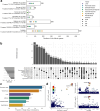This is a preprint.
Multi-omics characterization of type 2 diabetes associated genetic variation
- PMID: 39072045
- PMCID: PMC11275663
- DOI: 10.1101/2024.07.15.24310282
Multi-omics characterization of type 2 diabetes associated genetic variation
Abstract
Discerning the mechanisms driving type 2 diabetes (T2D) pathophysiology from genome-wide association studies (GWAS) remains a challenge. To this end, we integrated omics information from 16 multi-tissue and multi-ancestry expression, protein, and metabolite quantitative trait loci (QTL) studies and 46 multi-ancestry GWAS for T2D-related traits with the largest, most ancestrally diverse T2D GWAS to date. Of the 1,289 T2D GWAS index variants, 716 (56%) demonstrated strong evidence of colocalization with a molecular or T2D-related trait, implicating 657 cis-effector genes, 1,691 distal-effector genes, 731 metabolites, and 43 T2D-related traits. We identified 773 of these cis- and distal-effector genes using either expression QTL data from understudied ancestry groups or inclusion of T2D index variants enriched in underrepresented populations, emphasizing the value of increasing population diversity in functional mapping. Linking these variants, genes, metabolites, and traits into a network, we elucidated mechanisms through which T2D-associated variation may impact disease risk. Finally, we showed that drugs targeting effector proteins were enriched in those approved to treat T2D, highlighting the potential of these results to prioritize drug targets for T2D. These results represent a leap in the molecular characterization of T2D-associated genetic variation and will aid in translating genetic findings into novel therapeutic strategies.
Conflict of interest statement
Disclosures J.B.M is an academic associate for Quest Diagnostics Inc. Endocrine R&D. MIMcC is now an employee of Genentech and a holder of Roche stock.
Figures







References
-
- Jaacks L. M., Siegel K. R., Gujral U. P. & Narayan K. M. V. Type 2 diabetes: A 21st century epidemic. Best Pract. Res. Clin. Endocrinol. Metab. 30, 331–343 (2016). - PubMed
-
- Rusina P. V. et al. Genetic support for FDA-approved drugs over the past decade. Nat. Rev. Drug Discov. 22, 864–864 (2023). - PubMed
Publication types
Grants and funding
- R01 DK078616/DK/NIDDK NIH HHS/United States
- HHSN268201500001C/HL/NHLBI NIH HHS/United States
- R01 HL092577/HL/NHLBI NIH HHS/United States
- R01 HL105756/HL/NHLBI NIH HHS/United States
- P30 DK063491/DK/NIDDK NIH HHS/United States
- N01 HC025195/HL/NHLBI NIH HHS/United States
- HHSN268201500001I/HL/NHLBI NIH HHS/United States
- U01 HG011723/HG/NHGRI NIH HHS/United States
- U01 DK078616/DK/NIDDK NIH HHS/United States
- 75N92019D00031/HL/NHLBI NIH HHS/United States
- UM1 DK078616/DK/NIDDK NIH HHS/United States
- UL1 TR001881/TR/NCATS NIH HHS/United States
LinkOut - more resources
Full Text Sources
